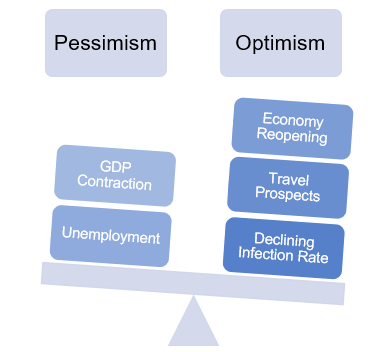Australia, through its phased opening, has rekindled positive market sentiments as many after a prolonged shutdown returned to their works. The operations have started picking up the pace, and the people once again are looking forward to going back to their usual set of routines. Australia, as compared to the rest of the nations, did a remarkable job in flattening the Covid-19 curve through its swift actions and strategic measures. However, few states like Victoria and New South Wales yet remain battered with a relatively higher number of cases.
ALSO READ: Global Virus Crisis: Morrison Says, “Clock is Ticking”, Australian Economy Must Reopen?
Although the Government has indicated substantial economic reopening by July, the dilemma yet persists regarding the new wave of infection. China, which reopened after the prolonged period of the shutdown, has started witnessing new cases. The current fragile state of the Australian economy after the closure and the absence of anti-coronavirus drugs or vaccines indicates that the nation in no way is ready to survive another wave of infection. The unemployment projection rate of around 10% while the amassing Treasury deficit highlights the widening trenches in the financial system of the country.
However, at the same time, the silver lining is evident through the prospective return of overseas students by July and Trans-Tasman travel talks, which are promising steady pace of economic pickup. Amidst such volatile market scenario, the investment decision often not only becomes challenging but a somewhat inexplicable task. The market uncertainty is generating an unresolved conflict between the intention to 'sell away' worries and the goal to 'buying and holding' hopes.

As we move through the period of financial crunch, let us see which strategy would emerge as the winner- Sell or Buy and Hold. Or is it your predicament that may determine the suitability of the plan.
Is Selling the Right Decision?
The dwindling stock prices on the stock market front tends to generate the investor’s apprehensions concerning the future value of their portfolio. Many investors amidst such volatile circumstances might plan to flee the market by selling off the stocks.
Selling of stocks may be right if the decision is triggered due to weakness in the fundamentals of the company. The weak balance sheet for the past couple of years may indicate that the company would be in doldrums during the crisis. However, the technical analysis demonstrating the stock price dwindling for the past few weeks may not be sufficient to highlight the company’s resilience in the future
The macroeconomic scenario and the impending crisis generally create downtrends in the market with the growing uncertainty amidst the investors. The declining price movements amidst the current situation, however, could be countered by the period of spurred economic activities which would boost to investor’s optimism. Thus, selling in a rush could also translate to regrets when the market picks the momentum, and the price for stocks start regaining.
Many experts believe that resorting to the short-term risky investment strategies can create lasting financial damage on the investor’s wallet. The short selling, which involves selling the stocks now with the plan to buy them in the future at low cost, can backfire the motives of the ordinary investors. The highly dicey strategy amidst the period of economic wavering may fail if the price of the stocks sold starts drifting upward rapidly.
Should you go for Buy and Hold?
Many investors perceive the market crunch as the flashy neon signs pointing at the “Sale” on the stock market. While the sale in the secondary market does not come with any dark coloured banners, they can be a harbinger of glad tiding for the investors looking for substantial discounts. However, the motivation to investment should not be primarily guided by short-term investment objectives.
Warren Buffet warns about not owning stocks for a few minutes if the intention is not to hold it for a longer duration. Given the current state of circumstances, the ray of hope in between the volatility in the stock market and the dwindling prices indicate the futility of the short-term investment plans. On the other hand, the long-term viewpoint may generate fruitful returns.
The historic market crunches have demonstrated the resilience of the stock market and the toughness of the world economy to recover from the shock. While the anti-coronavirus vaccine still is in trials, the immunity of the markets to rebound has been evident in many past exemplars. Learning from the previous lessons, investors using passive investment strategies can realise exponential gains on the investment. Meanwhile, Amidst the current turbulent scenario, it would allow the investors to tread safely and steadily by avoiding the significant risks that come along with the short-term plans.
ALSO READ: Five tips for finding opportunities in a bear market
Notably, the passive investment focus is accompanied by the significant motive of the value investment during the bearish phase. It would mean that invested capital goes into the companies which have steady cash flow and strong balance sheet. Investment in the undervalued stocks of blue-chip companies promises steady future gains with few headaches. Many companies have withdrawn their annual guidance that causes confusion is comparing the expected performance with the stock market benchmarks. However, the past performance can be placed against the industry standard for stock valuation in recent years.
ALSO READ: Guide to Investing in ASX Blue Chips
Bottomline
The wavering thoughts through the rocky journey often generate mayhem of emotions that shakes the foundations of the financial steadiness. The world grappling with pandemic has spurred a similar set of sentiments pushing the economic stability at the brink of the critical situation. As the people amidst the social distancing norms retracted to the confinements of their dwellings, the collateral damage on the economy soon started magnifying. However, the wound on economic health has already begun healing symbolising affirmative prospects. Considering the current predicament of the financial situation, the investor could utilise the long-term objective.



